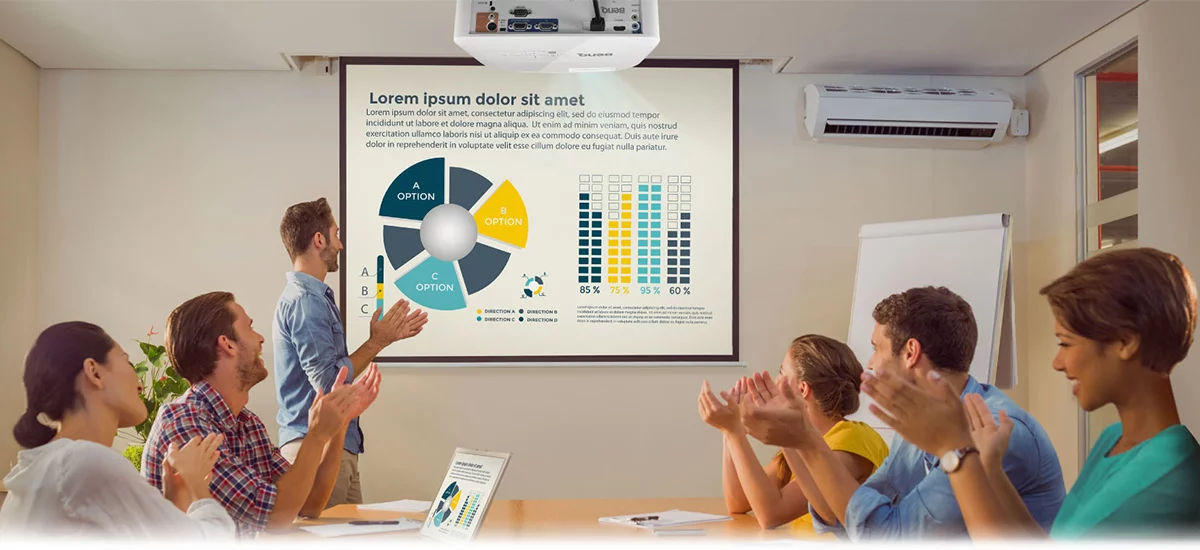In a world where change is the only constant, the landscape of business meetings is continually evolving. The traditional boardroom gatherings of yesteryears are giving way to innovative approaches driven by technology, globalization, and changing work dynamics.
CZUR’s Smart Meeting Projector revolutionizes collaboration with its innovative features. From wireless screen sharing to interactive whiteboard capabilities, it transforms any space into a dynamic meeting environment. With crystal-clear projection and seamless integration, it’s the ultimate tool for enhancing productivity and engagement in meetings and presentations.
As we venture into the future, several trends and innovations are poised to redefine how meetings are conducted, making them more efficient, inclusive, and impactful than ever before.
1. Virtual and Hybrid Meetings: The rise of remote work has accelerated the adoption of virtual meetings, allowing participants from across the globe to connect seamlessly. As technology continues to advance, virtual reality (VR) and augmented reality (AR) are poised to revolutionize the way we conduct meetings. Imagine stepping into a virtual conference room where colleagues appear as lifelike avatars, fostering a sense of presence and collaboration regardless of physical distance. Hybrid business meetings, combining in-person and virtual elements, will also become increasingly prevalent, catering to diverse preferences and enabling greater flexibility.
2. AI-Powered Meeting Assistants: Artificial intelligence (AI) is reshaping the meeting experience by providing intelligent assistants that streamline tasks and enhance productivity. AI-powered meeting schedulers can analyze participants’ schedules, preferences, and priorities to suggest optimal meeting times and durations, minimizing conflicts and maximizing attendance. During business meetings, AI assistants can transcribe discussions in real-time, highlight key points, and even offer insights based on past interactions, enabling more informed decision-making and follow-up actions.
3. Collaborative Tools and Digital Whiteboards: Collaboration lies at the heart of effective meetings, and digital tools are revolutionizing how teams brainstorm, plan, and visualize ideas. Digital whiteboards equipped with features like real-time editing, remote access, and integration with other software platforms facilitate dynamic collaboration, allowing participants to contribute ideas and concepts regardless of their physical location. These tools foster creativity, drive engagement, and ensure that everyone’s voice is heard, leading to more innovative outcomes.
4. Sustainability and Eco-Friendly Practices: With increasing awareness of environmental issues, businesses are reevaluating their approach to business meetings to minimize their carbon footprint. Virtual meetings significantly reduce travel-related emissions and associated costs, making them a more sustainable option. Additionally, companies are embracing eco-friendly practices such as digital documentation, reusable materials, and energy-efficient technology to reduce waste and promote environmental stewardship. Sustainable meetings not only benefit the planet but also reflect positively on brand reputation and corporate social responsibility.
CZUR’s Meeting Projector combines cutting-edge technology with intuitive design to streamline collaboration. Its advanced features include real-time annotation, multi-device connectivity, and remote control functionality, making it the ideal solution for modern workplaces seeking to elevate their meeting experience.
5. Emphasis on Inclusivity and Accessibility: Inclusive meetings ensure that all participants, regardless of their background or abilities, can fully participate and contribute. Accessibility features such as live captioning, sign language interpretation, and adjustable font sizes cater to diverse needs and ensure that meetings are accessible to everyone. Furthermore, companies are prioritizing diversity and representation in their meeting participants and leadership, recognizing the value of different perspectives and experiences in driving innovation and decision-making.
6. Data-Driven Insights and Analytics: Leveraging data analytics provides valuable insights into meeting effectiveness, attendee engagement, and decision outcomes. By analyzing metrics such as participation rates, duration, and topic relevance, organizations can identify patterns, trends, and areas for improvement. Advanced analytics tools can also predict meeting outcomes, recommend agenda topics, and highlight potential areas of conflict, enabling proactive management and optimization of business meeting processes.
7. Flexible Meeting Spaces and Agile Environments: The traditional notion of meetings confined to boardrooms is evolving, with organizations embracing flexible meeting spaces and agile environments. Collaborative workspaces equipped with movable furniture, adaptable layouts, and integrated technology foster creativity, innovation, and spontaneous collaboration. Whether it’s a casual brainstorming session in a lounge area or a formal presentation in a conference room, flexible meeting spaces accommodate diverse work styles and preferences, promoting dynamic interaction and productivity.
8. Immersive Meeting Experiences: The future of business meetings will be characterized by immersive experiences that blur the lines between physical and virtual environments. Augmented reality (AR) and virtual reality (VR) technologies are poised to revolutionize how meetings are conducted, offering interactive, lifelike simulations that transport participants to virtual boardrooms, collaborative workspaces, or even exotic locations. Immersive business meeting experiences not only enhance engagement and creativity but also provide a more memorable and impactful way to communicate ideas and concepts.
9. Emotional Intelligence and Human-Centered Design: As technology increasingly permeates every aspect of our lives, the human element remains central to effective communication and collaboration. Future meetings will place a greater emphasis on emotional intelligence and human-centered design, focusing on building rapport, empathy, and trust among participants. Techniques such as active listening, empathy mapping, and mindfulness practices will foster deeper connections and more meaningful interactions, leading to more productive and fulfilling meetings.
10. Continuous Learning and Development: Business meetings serve not only as platforms for decision-making but also as opportunities for learning and development. In the future, organizations will prioritize continuous learning initiatives within business meetings, offering training, workshops, and skill-building sessions to empower employees and foster professional growth. Incorporating elements of gamification, microlearning, and peer-to-peer mentoring will make meetings more engaging and effective as vehicles for knowledge sharing and development.
Conclusion
As we look ahead to the future of business meetings, it’s evident that innovation and adaptation will be the driving forces shaping this dynamic landscape. Virtual and hybrid formats will enable greater connectivity and collaboration across geographies, while AI-powered assistants and collaborative tools will enhance productivity and creativity. Sustainability, inclusivity, and data-driven insights will underpin meeting practices, ensuring that they align with evolving societal values and business priorities. Embracing these trends and innovations will not only transform the way we conduct meetings but also unlock new opportunities for growth, efficiency, and success in the digital age.
